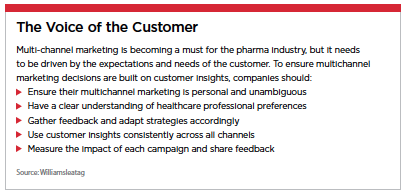Today, pharmaceutical marketers are under pressure to assess the channels and methods they have traditionally used to engage with customers in response to the changing behaviors and expectations of physicians, payers, and consumers.
That could take a shift in thinking for the industry, since despite a willingness to adopt new technologies for R&D purposes, pharma marketers have been slower to embrace new technologies and channels, according to CBR Pharma Insights. In this new, more complex era, pharma marketers need to adapt multichannel marketing strategies and find innovative ways to engage and reach customers. Equally, they need to ensure the message being delivered to the customer is consistent and that each touchpoint is complementary.
Meeting the Marketing Challenges Head On
Traditional marketing strategies, such as television and print as well as the sales rep visit to the physician, are no longer sufficient. Marketers need to adopt strategies that consider digital, native content, artificial intelligence, and relationship marketing.
Other valuable channels that pharma companies have been exploring include tele- and video detailing and physician communities.
All of these channels should be considered in the context of brand strategy and to generate new revenue streams, while balancing these approaches with medical awareness campaigns that address the needs of patients, physicians, and advocacy groups.
One of the issues that has held back marketers from deploying digital channels is concern over violating regulations around the way information is provided. Areas typically regarded as risky include social media, the use of big data for personalized targeting, and programmatic advertising. These concerns are not unfounded, given the heavy marketing related legal costs and penalties that companies have had to pay out, never mind the cost to brand and company reputation. It’s important, therefore, that marketers work with other teams, for example regulatory, to ensure the proper processes and controls are in place, including that content is compliant, has been properly translated, is complete, and is current.
In addition, for many marketing teams, the shift to a digital approach requires a different skillset as well as a new approach. To overcome these issues, marketing teams should work with digital teams to leverage the different tools available to them and build individual profiles of customers to better target their messaging.
To ensure seamless, integrated, and transparent marketing messages, delivered in ways that customers want to receive them, it’s also important for marketers to have a clear marketing plan with well-defined key performance indicators.
Putting Technology to the Test
Increasingly, customers expect a personalized and evidence-based approach to help with decision making. Leveraging digital platforms to share medical information with healthcare professionals can be a valuable way to share knowledge and gain trust and is increasingly important in the age where physicians are harder to reach in person.
Equally, consumers expect to be engaged in their healthcare journey and are looking for information online. Marketers need to find ways to intersect brand information with consumer online habits to get their message across most effectively. Engaging with consumers where they are and how they want to be reached, using the tools and resources available to support a conversation, will help to build strong relationships with consumers and empower them in their own healthcare journey. The patient is  also an important conduit to the physician, since if consumers have gained insights on a brand through various marketing channels they are likely to start a conversation about that brand with their physicians.
also an important conduit to the physician, since if consumers have gained insights on a brand through various marketing channels they are likely to start a conversation about that brand with their physicians.
Given the high cost of television advertising, marketers will also do well to consider whether their product might be better suited to a digital campaign, or at least reduce the spend on TV and invest more in digital marketing. In so doing, marketers will not only help to bring down the costs but also create more personalized and engaging online messaging.
In leveraging different digital and non-digital channels, marketers must be careful to ensure the message is consistent while also engaging customers in creative and meaningful ways. That will require marketers to develop the message in ways that are likely to resonate best in each channel, for example, using rich images on mobile sites and more detailed text on desktop sites. Getting the most from each touchpoint requires knowledge of how those platforms are used by customers and how the message will best resonate.
Changing with the Times
The ability to gather, analyze, report, and create insights from data can help marketers to segment the market and react to the specific needs of their stakeholders. Having information on customer preferences and habits requires continuous contact, leveraging digital channels such as emails, instant messaging, mobile applications, Facebook, and member forums, among others. By gathering this invaluable information and data from customers, marketers can respond quickly to individual needs.
To enhance the engagement, marketers can use machine learning and artificial intelligence to gather insights from big data, helping them to make quick decisions on which messages make the most sense to reach and engage with customers. This approach to market segmentation allows marketers to map each customer’s digital journey and determine what approach and content will help them to become more engaged or address their needs and concerns.
For example, marketers can gain a better picture of consumers with such seemingly disconnected information as the way the individual makes medical appointments, such as phone, text, email, how far they have to travel to their physician, how often they visit their practitioner, their age, demographic, family size, as well as type of illness.
But to achieve this, marketers need access to all types of data — structured and unstructured — from multiple different systems, both internal and external, and powered by AI to map the customer journey. In so doing, they are better positioned to respond to the customer in a way that is most likely to drive engagement, and, ultimately brand adoption.
By providing the right information, through the right channel, to the right customer and at the right time, pharma marketers can move beyond linear approaches and embrace a customer-centric, multichannel approach to reaching every stakeholder. (PV)
~~~~~~~~~~~~~~~~~~~~~~~~~
The Voice of the Customer
Multi-channel marketing is becoming a must for the pharma industry, but it needs to be driven by the expectations and needs of the customer. To ensure multichannel marketing decisions are built on customer insights, companies should:
Ensure their multichannel marketing is personal and unambiguous
Have a clear understanding of healthcare professional preferences
Gather feedback and adapt strategies accordingly
Use customer insights consistently across all channels
Measure the impact of each campaign and share feedback
Source: Williamsleatag
~~~~~~~~~~~~~~~~~~~~~~~~~
Executive viewpoints
 Brandie Linfante
Brandie Linfante
VP, Digital Engagement Strategy, Ogilvy CommonHealth Worldwide, a WPP Health & Wellness company
Data Driving Touchpoints at Time of Need and Interest
Technology and patient data availability can drive quality, focused, patient-centric communications resulting in improved awareness and education, translating to better patient care and outcomes. These technologies include prescription and consumer data, electronic health records, and patient apps — all making it possible to apply a laser-focused strategy for triggered content marketing, providing information at relevant touchpoints at a time of need and interest.
 Martha Maranzani
Martha Maranzani
VP, Content Strategy,
Ogilvy CommonHealth Worldwide, a WPP Health & Wellness company
Communications Built on Data
The influx of data and new data sources is changing the face of marketing. Where we only used to be able to customize messages to broad segments of customers, now we can personalize messages down to the individual level. Combining data such as HCPs’ engagement habits, their media consumption, and their device habits with rep-collected customer relationship management (CRM) data, pharma marketers have a powerful backbone of data on which to build their future communications.
 Paul Balagot
Paul Balagot
Chief Experience Officer,
precisioneffect
AI-Powered Chatbots
Because each patient experience is variable and unique, one of the technologies we’ve used to address them in their exact moment of need is AI-powered chatbots. We’ve launched a couple of different branded bots for our pharma clients. The bots are able to deliver highly relevant content that is specific to each patient and the information they need at any given moment of their journey. This advancement in technology brings renewed meaning to delivering the right content, to the right patient at the right time.
 Wayne Page
Wayne Page
Senior VP, Accounts
and Strategy, London,
precisioneffect
Breaking Down the Barriers in Multichannel Marketing
My top three challenges to executing a multi-channel marketing campaign — for today, it changes weekly — are the following. First, the speed of change within MCM means that companies are finding it difficult to keep up with developments, let alone have proficiency in them.
Second, communications are usually owned by multiple departments with different functions. Breaking down barriers is vital for developing integrated campaigns that provide a consistent user experience. And, third, an absence of effective measurement or integrated data strategies results in waterfall projects rather than agile, evolving strategies with increasingly rich returns. Oh, as a bonus, don’t forget the small issue of consent in the European Union.
 Jim O’Dea
Jim O’Dea
President and CEO
Rx EDGE Media Network
Think Consumer First
Multi-channel means thinking “consumer first." The challenge is in integrating messages in the channels that have the most impact for your target audience.
Too many pharma messages are forced onto consumers when they aren’t looking for them, which does not lead to action. Traditional marketing channels have been redefined to be anywhere where there is the greatest opportunity to influence and educate…that includes the pharmacy. Think hard about where and when your patients will be receptive to new information.
 Rob Blazek
Rob Blazek
Senior VP, Networks
& Analytics,
Rx EDGE Media Network
Data Maximization
Using data to plan and optimize marketing campaigns allows you to maximize the value of your client’s investment. It’s imperative to use multiple data sources and fit them together properly to achieve the client’s objectives, but not miss opportunities by overthinking.
Collaboration among partners and sharing key information throughout a campaign will always produce more actionable insights. Most importantly, the data needs to come from a trusted source and be analyzed using a time-tested, validated methodology.


















